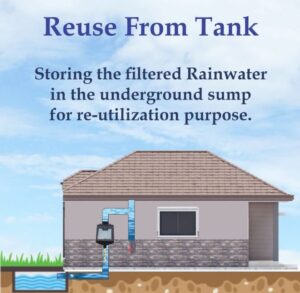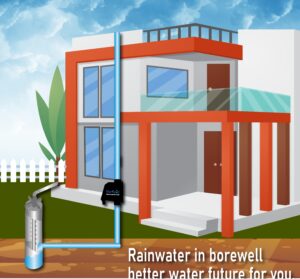Water is our most precious natural resource and essential for all life and it plays an important role in transforming the lives of people to better and healthier one. Do you know that the scarcity of water continue to be a growing problem. But the best way to conserve water is its judicious use. Demand for processed supply water is rising day by day due to an increasing population, urbanization, industrialization.
Nowadays, access to sufficient amount of water is a major issue to most people living in both rural and urban areas. Now, how to overcome from this? Well, here you go. Rainwater harvesting is the most acceptable and viable solution to help solve water crisis problems for various sectors. To this day, the concept of rooftop rainwater harvesting for house has been accepted all over the world.
Rooftop Rainwater Harvesting for House
- What is rainwater harvesting and why is it important?
Rainwater is one of the purest sources of water available as it contains very low impurities. Harvesting rainwater is an ancient practice and you might have thought why are we practicing it? Because, till today this valuable practice in growing in popularity due to its various benefits in our modern times. Rooftop rainwater harvesting (RWH) is the most acceptable and sustainable method/solution to attenuate water crisis issues in the both rural and urban areas all over the world. The system involves simple collection and storing of rainwater from surfaces it falls so that it can be used for later use (domestic, commercial or agriculture purposes).
Now, the time to take initiative for rainwater harvesting for houses has arrived. Why because the idea behind the process of rainwater harvesting is very simple. Rainwater harvesting, in its broadest sense, is a modern way of saving water at home/house. Rainwater harvesting has brought more relief during times of droughts. It is the best possible way to save water and invoke the society towards the importance of water. So, it really makes sense to set up a rainwater harvesting system now.
- How can you do rainwater harvesting for house?
Over the last few years, major parts of the world have been facing continuous inadequate water supply. So, it’s all-important to take adequate measures to meet the increasing demands of water for domestic use. Have you implemented rainwater harvesting system for your house? If YES, then it’s great! If No, then it’s not too late. Even, now also you can implement the system to reduce your demand on mains water supply. Rooftop and surface runoff are the rainwater harvesting methods. Choosing the right method for harvesting rainwater is essential to making your home more sustainable and such method is the rooftop rainwater harvesting method.
Basically, urban and rural models are the two models associated with rainwater harvesting for houses.
- Rural model:
In rural areas, house roofs are built with sheets or bricks and etc. Here, rainwater comes to the edges easily and hence water can be collected through rain gutters. Rural people use fine cloth material to filter the rainwater from the roof. Here, collected water can be used to store water either for domestic use, livestock, or for agricultural needs.
 Rooftop Rainwater Harvesting for Rural House
Rooftop Rainwater Harvesting for Rural House
- Urban model:
Here, rainwater from the house roof is collected through rainwater gutters and stored in a storage tank. The system is designed to support both potable and non-potable needs of the family at their doorstep. Rooftop rainwater harvesting for recharging groundwater is a common practice implemented in individual houses.
 Rainwater Harvesting for Urban House
Rainwater Harvesting for Urban House
End use of harvested rainwater at homes: garden/lawn irrigation, toilet flushing, Laundry, car washing, showering/bathing, and even for drinking (by using water treatment methods).
Rainwater harvesting for house systems (Rural model and Urban model) comprises some basic components and are as follows:
- A catchment area: Rooftop of the house will be the area to capture rainfall.
- A conveyance system: To move the captured rainwater from the roof to a storage area (maybe piping)
- A storage system: To hold the rainwater for future use — a barrel, a cistern or a tank
- A distribution system: To get the water from storage to where it is being used
3. Top benefits of installing rainwater harvesting system for your house
Some of the top benefits of collecting and storing rainwater for your homes are listed below:
- Greatly promotes water conservation and saves money on water bills
- Excellent and valuable source of water in the emergencies
- The system is easy to install, operate and maintain for all types of houses with less investment
- This system can be set up for houses in rural, suburban and as well as urban areas
- Reduces rainwater runoff and solve drainage problems at your house
- The system saves water at home by diminishing the dependency on ground water and municipal water supply
- It is an ideal solution in the areas, which faces the inadequacy of water
- Substantially reduces the consumption of potable water for various purposes
“Rainwater harvesting for house is the best and effective way to end water scarcity at your house and it enhances green living too!”
Neerain is proud to republish this article for spreading awareness about situation of water, for our stakeholders. Credit whatsoever goes to the Author.
This article is published by: –
https://www.neoakruthi.com/blog/rainwater-harvesting-for-house.html
We would like to spread this for the benefit of fellow Indians.
